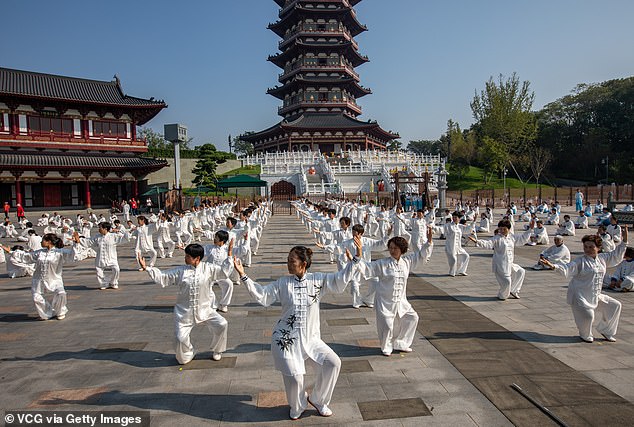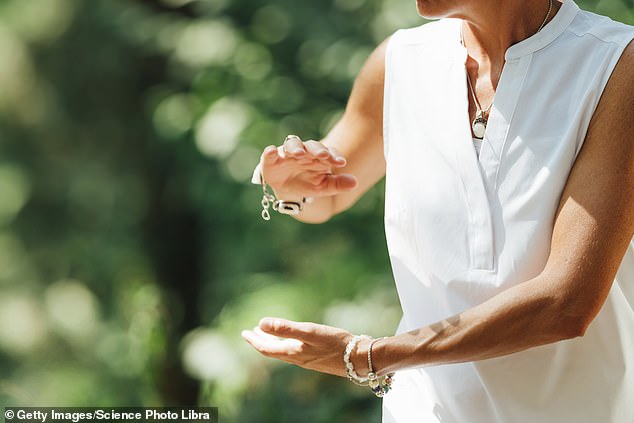An ancient Chinese exercise technique has gone viral on social media, and experts say that it could be the key to healthy ageing.
The routines—known as qigong—have amassed millions of views online, with people dubbing them ‘longevity exercises’.
In one video posted earlier this month, which has been viewed nearly 100,000 times, wellness influencer Anna Li performs a five step qigong routine.
In the caption she joked: ‘POV; you used to cringe at your Chinese mom for doing these exercises… Now they are going viral and you have to tell her she was right.’
Similarly, videos of Chinese grandmas doing the traditional exercises in their local parks have also gone viral in recent weeks.
Qigong is a 4,000-year-old traditional Chinese medicine practice that blends intentional movement, meditation and breathing practices.
It is based on the principle that the body has free flowing energy but being sedentary results in that energy stagnating and hindering the body’s ability to heal.
‘Qi’ means air, breath of life or vital energy of the body, and ‘gong’ means the skill of working with, or cultivating self-discipline and self-healing.
So the belief is that qigong reduces stagnation of that energy, allowing the body to better heal itself.

Qigong is a 4,000-year-old traditional Chinese medicine practice that blends intentional movement, meditation and breathing practices
‘Qigong is really an umbrella term for movement exercises that range from meditative practices to martial arts,’ says Peter Deadman, a Qigong specialist from the UK Centre of Chinese Medicine.
‘They have always been focused on living a long life, mainly because the philosophical grounding is Daoism which does not have the Christian tradition of an afterlife—but the key is really that they help with healthy longevity.’
Thankfully you don’t need to jet to Beijing to learn how to perform Qigong as there are hundreds of free tutorial videos available to watch online.
One YouTube channel, Qigong for Vitality, has over 179,000 subscribers and offers 200 videos for people of all ages and fitness levels.
One of the benefits of Qigong is that it is easy to follow along with and get into.
Accessible exercises for newbies to try are the awakening stretch, a simple morning move where you lift your arms overhead, rise onto your toes and lower your hands slowly, and cloud hands—a slow side-to-side motion where the hands glide across the body.
More vigorous activities include a whole body shake, or a punch with a twist, a controlled but forceful punching exercise done in steady sequences, often with coordinated breathing and a light twist of the waist.
Other exercises include body tapping, which involves slapping or hitting the acupuncture points—such as the arm pits across the chest or in the neck—to relieve stress.

Another exercise is known as holding the ball, a basic standing posture: arms rounded as if cradling a ball, knees soft, shoulders relaxed
The theory is that tapping can boost the body’s lymphatic system.
The lymphatic system is a network of vessels, nodes, and organs that helps remove toxins, waste, and excess fluid while supporting your immune system.
A quick ‘lymph wake-up’ involves lightly tapping key lymph node areas to stimulate flow. Start with your neck, then move to armpits, groin, and abdomen, using your fingertips in a gentle, rhythmic motion for 30-60 seconds per area.
Proponents say the deep breathing elements to the routine also help stimulate the lymphatic system.
When you inhale deeply, the diaphragm contracts and moves downward, creating a vacuum-like effect in the thoracic cavity.
This action helps pull lymph fluid through the thoracic duct, the largest lymph vessel in the body, facilitating its movement and drainage.
Experts say that the real benefit to qigong though is that it focuses the mind.
‘They key to qigong is that it cultivates three separate functions at the same time,’ says Mr Deadman.

A major review of 77 studies published in 2010 by American researchers showed that either qigong or tai chi is able to benefit bone health
‘These exercises involve deep diaphragmatic breathing, which helps to move the body away from a feeling of stress, as well as focusing the mind, unlike many western workouts where you see people running on a treadmill and watching a film, and of course the movement helps the body.’
‘The combination of all three is where the magical effect comes from ‘
Studies have suggested that the exercises have a range of health benefits.
A major review of 77 studies published in 2010 by American researchers showed that either qigong or tai chi is able to support bone health, was beneficial to both the heart and lungs as well as helping to reduce symptoms of depression and anxiety.
While a 2023 review of qigong studies found that the practice changes the hippocampus and prefrontal cortex of your brain in ways that may support memory, spatial awareness, focus and information processing.
‘The benefits of qigong have been a bit lost in the west, with people focusing instead on yoga, but it can be really beneficial for both physical and mental health and in turn health ageing,’ says Mr Deadman.